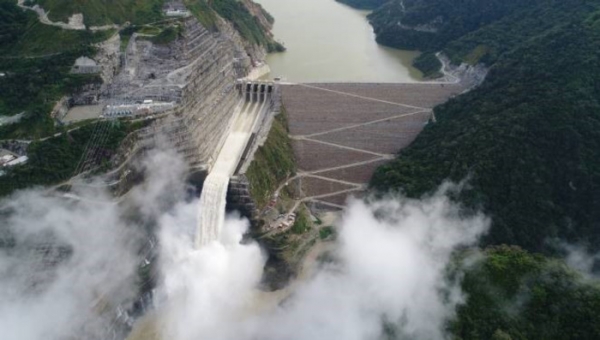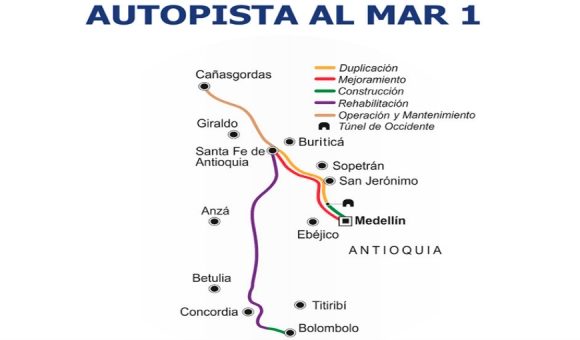Hidroituango Contractor Lawsuit Could Produce Huge Loss for EPM: Court Risks, Counter-Suits, Lost Power Sales, Insurance Denials, Delays, Grid Reliability Charges

EPM’s professional employees union Sinpro on September 4 unveiled a disturbing analysis warning that residents downstream of the Hidroituango hydropower project who earlier sued EPM could seek to grab at least some of the COP$9.9 trillion/US$2.6 billion damages award being sought by EPM in a “conciliation” lawsuit against Hidroituango contractors and insurers.
Sinpro adds that the EPM “conciliation” lawsuit also could result in forfeit or lengthy delay — 10 years or more in Colombia’s plodding courts — to recover significant portions of the COP$5.3 trillion (US$1.4 billion) Hidroituango damages policy that EPM has with Hidroituango project insurer Mapfre.
What’s more, if EPM cancels or fails to renew its existing Hidroituango construction deals with its now-sued construction contractors (those contracts are currently set to expire at year-end), then getting a replacement contractor (or contractors) up-to-speed could result in even more costly delays to complete the Hidroituango project, Sinpro warns.
Even an extra one-year delay would cost EPM some COP$2.6 trillion (US$700 million) in lost power sales, on top of millions more dollars in grid-reliability-charges that would be imposed by Colombia’s electric power regulator (CREG), the group warns.
In addition, the calculation doesn’t include the possibility that EPM eventually could lose its contentious US$2.6 billion damages claim in the courts, now having apparently dismissed the option of a possibly friendlier — even if smaller — settlement deal.
What’s more, EPM management’s bypassing of its own Board of Directors in the abrupt “conciliation” lawsuit decision – a move that prompted a mass EPM Board resignation — triggered a Wall Street downgrading of EPM’s debt rating and stoked fears among major lenders, Sinpro noted. Further ratings-downgrades, prepayment demands and higher interest charges potentially could cripple EPM’s finances.
According to Sinpro, just adding-up the potential losses in a possibly successful counter-suit by Hidroituango downstream residents, plus the possible loss or delays in Mapfre insurance coverage, plus the huge costs of additional construction delays and future CREG fines, could produce an up-to-US$2.1 billion net loss to EPM, rather than a presumed US$2.6 billion gain.
This all triggered by a risky “conciliation” legal maneuver pushed by a new EPM general manager (a lawyer) and a young, inexperienced, populist Mayor who raised “conflict-of-interest” assertions against the former EPM board, some former EPM managers, former Mayors and Medellin’s empresarial class (Grupo Empresarial Antioqueño, GEA).
Prior to the January 2020 election of Medellin Mayor Daniel Quintero — and Quintero’s appointment of EPM’s new General Manager Alvaro Rendon – EPM had argued that the Hidroituango diversion-tunnel collapse that caused severe damage to the machine room and enormously costly delays in power sales essentially was the result of unforeseeable Cauca River flooding that led to unforeseeable tunnel damage. Insurer Mapfre was already starting to pay damage claims under EPM’s policy, which covers “unforeseeable” events.
However, a technical study by engineering consultant Skava last year found that insufficient sealing of the floor of the diversion tunnel – arguably an engineering error — contributed to the collapse (see Medellin Herald July 11, 2019, “Design Flaw Caused Hidroituango Tunnel Collapse.”)
But as EPM’s management and Mayor Quintero seem to be discarding the prior “unforeseeable events” argument and instead switching to “contractor error” arguments, then at least part of the COP$5.3 trillion (US$1.4 billion) Mapfre insurance claim could be at risk — along with potentially huge downstream-resident counter-suit claims that could cite “error” arguments rather than “unforeseen event” arguments, Sinpro warns.
By the time lawsuit claims get a court ruling, Mayor Quintero likely will have long exited the Mayor’s office, as his term ends in 2023. As Sinpro warns, the “conciliation” lawsuit battle could stretch to 2030 and even beyond — unless Quintero agrees to a rapid settlement that possibly could produce less-than EPM’s asked-for US$2.6 billion claim.
What’s more, quickly settling for less than US$2.6 billion – even though this might prove to be a wise financial solution for cash-strapped EPM — potentially could force EPM to charge higher electricity rates for several years, to recover part of its Hidroituango losses.
Higher electricity rates would be an immediate political problem for Quintero, who campaigned on a populist EPM “rate freeze” promise.
On the other hand, a lengthy court battle — though financially damaging to EPM in the short-term and possibly even in the long-term — could be safer politically for Quintero, since he wouldn’t be around in 2030 to take the blame for any court judgment giving EPM less-than-it’s-asking-for. Or (even more so) if the court eventually hands EPM a catastrophic denial of its claims.
















